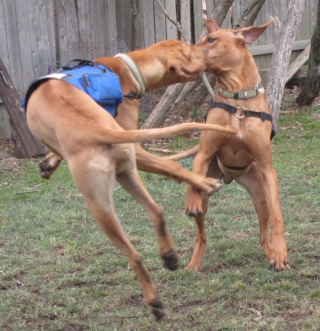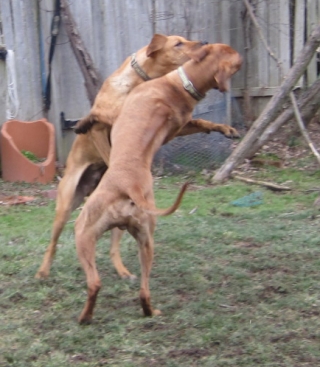Dancing with the Stars Rhodesian Ridgeback Style


Socialization for your pup or dog is key to raising a healthy, stable animal. Socialization is exposure to SIGHTS, SOUNDS, SCENTS AND SURFACES paired with positive experience. Socialization is to people of all ages, other dogs (both on and the especially raucous off leash type of socializing), other animals and different places at different times of the day and throughout the year. Whether your plans for your dog include companionship, competition, assistance or other types of work dog -- or all of the above and then some -- it is critically important to find time, make the effort and commit regardless of season when pup is acquired to helping that animal. No matter the breed, size, gender or geography . Puppyhood lasts until 16 weeks or four months of age -- miss that window and you have some extra work to do. Acquire your dog after that age and unless his or her early life included lots of obvious experience out in the world based on behavior observations, you'll have some catching up to do. Understanding where your dog's strengths and weaknesses are is key to helping resolve issues. If you're in over your head and your dog is getting more fearful either by acting out or shutting down or sometimes one and then the other, despite your best efforts, you might want to seek professional help.
I have had the unique pleasure of getting to know two different Rhodesian Ridgebacks this past winter, Karlo and Taj.
Both dogs are true to the Ridgeback temperament:
Temperament
Rhodesian Ridgebacks are loyal and intelligent and somewhat aloof to strangers. This is not to be confused with aggression; a Ridgeback of proper temperament will be more inclined to ignore, rather than challenge, a stranger. This breed requires positive, reward-based training, good socialization and consistency; it is often not the best choice for inexperienced dog owners. Ridgebacks are strong-willed, intelligent, and many seem to have a penchant for mischief, though loving. They are protective of their owners and families. If trained well, they can be excellent guard dogs, although this particular trait should not be encouraged. Like any dog, they can become aggressive when they are not socialised properly.
Despite their athletic, sometimes imposing, exterior, the Ridgeback has a sensitive side. Excessively harsh training methods, that might be tolerated by a sporting or working dog, will likely backfire on a Ridgeback. The Ridgeback accepts correction as long as it is fair and justified, and as long as it comes from someone he knows and trusts. Francis R. Barnes, who wrote the first standard in 1922, acknowledged that "rough treatment ... should never be administered to these dogs, especially when they are young. They go to pieces with handling of that kind.
It's been a privilege to have helped guide them to individual and collective success.They have developed a rollicking friendship. They have both overcome fears and reactivity issues. These dogs are both male, born within two days of each other in June 2012. I met Karlo before his window of puppyhood was over and have had regular contact with him since. He is a regular board and train dog who comes and moves in for various lengths of time when his owners vacation; Taj (I nicknamed him Mr. Mahal) lives with a lovely young couple who contacted me when Taj was nearly 8 months old. He initially presented as more disturbed than his owners had reported -- he exhibited great anxiety easily manifesting in shutting down or acting out. He was a mess on a leash -- pulling, zigging and zagging and despite using a choke chain there was a lot of struggling, especially when encountering other dogs or squirrels or similar distractions. He also had had limited dog dog play and was a bit of a mess inside at times as well and had very limited cues or commands. A private training, incorporating Har-Vest (for both on and off leash work as it calmed him tremendously) and teaching owners the tenets of The Six Pillars of Dog Training Wisdom gave Taj and his owners the boost they needed to overcome those early deficits and get him on the road to normalcy. And I'm pleased to report that Taj has caught up and has become a most delightful adolescent.
As spring begins the pair have had the good fortune to get together several times this week while Karlo is visiting. While they are both able to play with other dogs well, they especially enjoy each other. In observing and taking some pictures, as these dogs like to play rough, hard and fast, I can't help but thinking their physicality sometimes resembles a ballet or ballroom dance routine. Here's a series of shots illustrating their antics:
Games of chase are a joy to watch. Warm up to dancing!
Checking out Gretch The Cat!
Karlo and Taj practice the Paso Doble
The Fox Trot sans Har-Vest
Taj expresses his inner artistry in this freestyle dance.
Want to learn more and stay up to date with A Better Pet and Har-Vest? You'll see additional Karlo and Taj shots along with other friends of A Better Pet -- using visuals to demystify real life dog training and help make yours a better pet.
To join on in LIKE us at our FACEBOOK A BETTER PET and FACEBOOK HAR-VEST.




